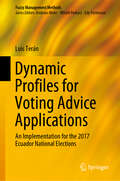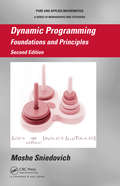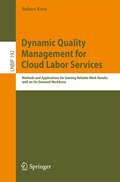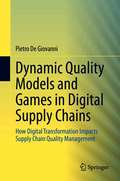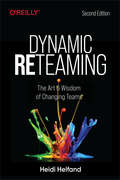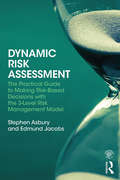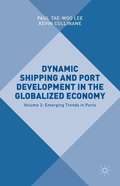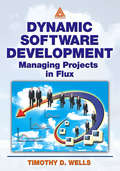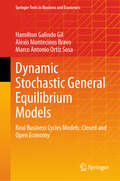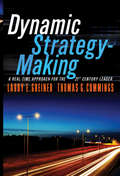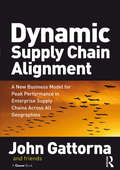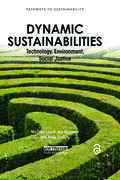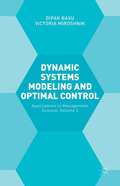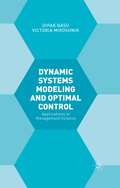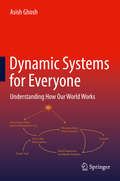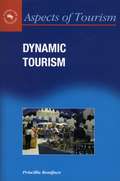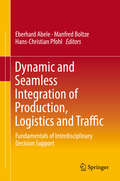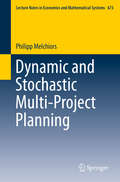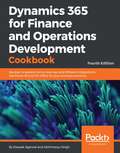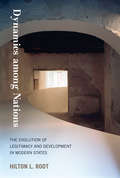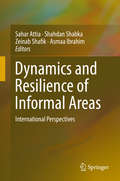- Table View
- List View
Dynamic Profiles for Voting Advice Applications: An Implementation for the 2017 Ecuador National Elections (Fuzzy Management Methods)
by Luis TeránElectronic participation is an emerging and growing research area that makes use of internet solutions to enhance citizens' participation in government processes in order to provide a fair and efficient society. This book examines recommender-system technologies and voting advice applications as tools to enable electronic citizen participation during election campaigns. Further, making use of fuzzy classification, it provides an evaluation framework for eParticipation. A dynamic voting advice application developed for the 2017 Ecuador national election serves as a real-world case study to introduce readers to the practical implementation and evaluation issues. The book concludes with a comprehensive analysis of the 2017 election project based on altmetrics, Google Analytics and statistics from the case study.
Dynamic Programming: Foundations and Principles, Second Edition (Chapman & Hall/CRC Pure and Applied Mathematics)
by Moshe SniedovichIncorporating a number of the author's recent ideas and examples, Dynamic Programming: Foundations and Principles, Second Edition presents a comprehensive and rigorous treatment of dynamic programming. The author emphasizes the crucial role that modeling plays in understanding this area. He also shows how Dijkstra's algorithm is an excellent exampl
Dynamic Quality Management for Cloud Labor Services
by Robert KernHow can a scalable and efficient quality management mechanism for cloud labor services be designed in a way that it delivers results with a well-defined level of quality to the requester? Cloud labor services are a specific form of crowdsourcing: A coordination platform serves as an interface between requesters who need to get work done and a large crowd of workers who want to perform work. An early example of such a platform is Amazon's Web marketplace Mturk, on which service requesters can publish open calls for so-called human intelligence tasks (HITs). Robert Kern's work makes a considerable contribution toward solving the quality problem for scalable human work. On the basis of a comprehensive framework of cloud labor, he develops a set of methods to conceptually measure and aggregate the quality of human work results, implements a platform to put those methods to work, and evaluates their application in a number of very compelling, real-world scenarios successfully combining concepts from statistics, information technology, and management. Reading this book will be beneficial to novices in cloud labor services looking for orientation in this new field as well as to advanced researchers and practitioners developing cloud quality concepts.
Dynamic Quality Models and Games in Digital Supply Chains: How Digital Transformation Impacts Supply Chain Quality Management
by Pietro De GiovanniThis book bridges the fields of Supply Chain Management, Digital Transformation, and Dynamic Quality models in order to illustrate how digital transformation affects the work of researchers and managers in Supply Chain Quality problems. It aims to address the gap in scholarship regarding new technologies, updating the established literature to reimagine theoretical models, dynamic games, knowledge management, supply chain coordination solutions, interfaces in circular economies, and other functional spaces for a digital era. Written for researchers, managers, and practitioners, this book offers an accessible approach to the topics through clear, management-oriented chapters, reserving mathematical background for the Appendices. It discusses an array of modern challenges in digitization, including smart device installation, Cloud data accessibility, applications of AI systems, Supply Chain monitoring via Blockchains, using sensors in operations, and digital tool integration within traditional IS frameworks.
Dynamic Reteaming: The Art and Wisdom of Changing Teams
by Heidi HelfandYour team will change whether you like it or not. People will come and go. Your company might double in size or even be acquired. In this practical book, author Heidi Helfand shares techniques for reteaming effectively. Engineering leaders will learn how to catalyze team change to reduce the risk of attrition, learning and career stagnation, and the development of knowledge silos.Based on research into well-known software companies, the patterns in this book help CTOs and team managers effectively integrate new hires into an existing team, manage a team that has lost members, or deal with unexpected change. You’ll learn how to isolate teams for focused innovation, rotate team members for knowledge sharing, break through organizational apathy, and more.You’ll explore:Real-world examples that demonstrate why and how organizations reteamFive reteaming patterns: One by One, Grow and Split, Isolation, Merging, and SwitchingTactics to help you master dynamic reteaming in your companyStories that demonstrate problems caused by reteaming anti-patterns
Dynamic Risk Assessment: The Practical Guide to Making Risk-Based Decisions with the 3-Level Risk Management Model
by Stephen Asbury Edmund JacobsDynamic Risk Assessment is the key tool to support a holistic risk management framework. This book aims to help employers, managers and staff alike to understand how they can effectively integrate dynamic risk assessment into business management processes and systems to improve safety. With tips, examples and solutions throughout, this multi-disciplinary text delivers an effective and comprehensive approach to help you to understand how dynamic risk assessment (DRA) can be integrated into predictive (PRA) and strategic risk assessments (SRA) to enhance your organization’s effectiveness. The 3-Level Risk Management Model fully supports and complements the systematic ‘five steps to risk assessment’ process A multi-disciplinary approach to dynamic risk assessment that covers workers operating in teams and those working alone within the public, private and third sectors Contains practical examples, tips and case studies drawn from a wide range of organizations The book comes with access to downloadable materials from an accompanying website at: www.routledge.com/cw/dynamic-risk-assessment
Dynamic Shipping and Port Development in the Globalized Economy: Volume 2: Emerging Trends In Ports
by Paul Tae-Woo Lee Kevin CullinaneThis two volume book presents an in-depth analysis of many of the most important issues facing today's shipping and port sectors. Volume 2 of Dynamic Shipping and Port Development in the Globalized Economy focuses on the emerging trends in ports.
Dynamic Software Development: Managing Projects in Flux
by Timothy WellsThe ever changing nature of information makes the job of managing software development notoriously difficult. Dynamic Software Development: Managing Projects in Flux eases the burden by defining the principles, practices, skills, and techniques needed to manage a dynamic development environment. At a hands-on level, the text helps managers define t
Dynamic Stochastic General Equilibrium Models: Real Business Cycles Models: Closed and Open Economy (Springer Texts in Business and Economics)
by Hamilton Galindo Gil Alexis Montecinos Bravo Marco Antonio Ortiz SosaThis textbook guides the student step-by-step in developing and solving a DSGE (Dynamic Stochastic General Equilibrium) model–not only from the technical and conceptual aspects but also through the simulation process of each model. Characterized by a learning-by-doing approach, the book is set apart from the extant textbooks in three ways. First, it performs all the algebra associated with each model, such as the calculation of steady-state and the log-linearization of the model. Second, each model developed has been generated in Dynare, and every chapter is accompanied by a set of codes (mod-files and m-files) that the reader can use to replicate the model developed in every chapter. Finally, the models considered are toy models in the closed and open economy, which allows the student to learn the basic lessons and understand the fundamental relationships of the variables. All of this prepares the student to deal with more complex models. This book is intended for advanced undergraduate or beginning graduate courses in economics, finance, or applied mathematics, as well as practitioners in central banks that use these models daily in the preparation of forecasts or simulations of aggregate variables.
Dynamic Strategy-Making
by Thomas G. Cummings Larry E. GreinerPraise for Dynamic Strategy-Making"An astonishingly timely, hopeful, and important book that recasts and freshly imagines strategy-making and integrates theory with practice in the field of strategic management. A must-read for all those who want to learn more about the future of strategy practice and become more skillful at it." -Warren Bennis, Distinguished Professor of Business, University of Southern California; and coauthor, Transparency"This is one of the most valuable resources ever created for strategists and leaders in organizations. It uniquely combines concepts of leadership and organization with strategy content and implementation in a pragmatic and integrated approach that makes tremendous sense for our times. With concrete cases, it provides a clear road map for those who want and need to do a better job of formulating and implementing strategy." -David A. Nadler, vice chairman, Marsh & McLennan Companies; senior partner, Oliver Wyman-Delta Organization and Leadership; and author, Building Better Boards and Competing By Design"The authors correctly focus on the new dynamic of 24/7 competition and change and the need for organizations to be fast, fluid, and flexible. It is a must-read for managers of tomorrow and offers a number of practical insights and lessons on how to proceed with strategy execution that can be readily adopted in any organization. It is a call to action that few can afford to ignore." -Manjit Singh, chairman, Sony Entertainment Television, India; and former CEO, Compete Inc., High Circle, Future Step, and Korn/Ferry International
Dynamic Supply Chain Alignment: A New Business Model for Peak Performance in Enterprise Supply Chains Across All Geographies
by John GattornaJust like the world financial system, but for different reasons, 21st-century corporations need a new business model for their enterprise supply chains. The old conventions no longer work in this new world of volatile and increasingly unpredictable demand and supply. The enterprise needs to become more 'connected' to its own parts, as well as its partners up and down the chains it participates in. So too, we need to embrace new ways of looking at customers to gain deeper, more insightful impressions of what they are telling us about the way they want to buy our products and services. Finally, these signals need converting into corresponding action, driven by the people in the business, leaders and staff alike, who are aligned to their customers' wishes. This is the world of dynamic supply chain alignment where, increasingly, supply chains are the business. In the follow-up to his hugely successful Strategic Supply Chain Alignment, John Gattorna's Dynamic Supply Chain Alignment, explores how to create and sustain multiple supply chains with a level of flexibility and responsiveness that allow you to respond to opportunities and threats; at the same time aligning with your suppliers, your partners and your customers. When more executives get to this stage of development the profits will flow more readily, and sustainability of performance will not be the same issue it is today. The way forward is right there in front of us; but, says John Gattorna, we must throw off old ways and embrace the new.
Dynamic Sustainabilities: "Technology, Environment, Social Justice"
by Ian Scoones Melissa Leach Andrew Charles StirlingLinking environmental sustainability with poverty reduction and social justice, and making science and technology work for the poor, have become central practical, political and moral challenges of our times. These must be met in a world of rapid, interconnected change in environments, societies and economies, and globalised, fragmented governance arrangements. Yet despite growing international attention and investment, policy attempts often fail. Why is this, and what can be done about it? How might we understand and address emergent threats from epidemic disease, or the challenges of water scarcity in dryland India? In the context of climate change, how might seed systems help African farmers meet their needs, and how might appropriate energy strategies be developed? This book lays out a new 'pathways approach' to address sustainability challenges such as these in today's dynamic world. Through an appreciation of dynamics, complexity, uncertainty, differing narratives and the values-based aims of sustainability, the pathways approach allows us to see how some approaches are dominant, even though they do not produce the desired results, and how to create successful alternative 'pathways' of responding to the challenges we face. As well as offering new ways of thinking about sustainability, the book also suggests a series of practical ways forward - in tools and methods, forms of political engagement, and styles of knowledge-making and communication. Throughout the book, the practicalities of the pathways approach are illustrated using four case studies: water in dryland India, agricultural seeds in Africa, responses to epidemic disease and energy systems/climate change. Published in association with the Economic and Social Research Council (ESRC)
Dynamic Systems In Management Science
by Alexis LazaridisDynamic Systems in Management Science explores the important gaps in the existing literature on operations research and management science by providing new and operational methods which are tested in practical environment and a variety of new applications.
Dynamic Systems Modeling and Optimal Control: Applications In Management Science
by Victoria W. Miroshnik Dipak BasuDynamic Systems Modelling and Optimal Control explores the applications of oil field development, energy system modelling, resource modelling, time varying control of dynamic system of national economy, and investment planning.
Dynamic Systems Modelling and Optimal Control: Applications in Management Science
by Dipak Basu Victoria MiroshnikDynamic Systems Modelling and Optimal Control explores the applications of oil field development, energy system modelling, resource modelling, time varying control of dynamic system of national economy, and investment planning.
Dynamic Systems for Everyone: Understanding How Our World Works
by Asish GhoshSystems are everywhere and we are surrounded by them. We are a complex amalgam of systems that enable us to interact with an endless array of external systems in our daily lives. They are electrical, mechanical, social, biological, and many other types that control our environment and our well-being. By appreciating how these systems function, will broaden our understanding of how our world works. Readers from a variety of disciplines will benefit from the knowledge of system behavior they will gain from this book and will be able to apply those principles in various contexts. The treatment of the subject is non-mathematical, and the book considers some of the latest concepts in the systems discipline, such as agent based systems, optimization, and discrete events and procedures. The diverse range of examples provided in this book, will allow readers to:Apply system knowledge at work and in daily life without deep mathematical knowledge;Build models and simulate system behaviors on a personal computer; Optimize systems in many different ways;Reduce or eliminate unintended consequences;Develop a holistic world view .This book will enable readers to not only better interact with the systems in their professional and daily lives, but also allow them to develop and evaluate them for their effectiveness in achieving their designed purpose.Comments from Reviewers: “This is a marvelously well written introduction to Systems Thinking and System Dynamics - I like it because it introduces Systems Thinking with meaningful examples, which everyone should be able to readily connect” - Gene Bellinger, Organizational theorist, systems thinker, and consultant, Director Systems Thinking World “Excellent book ...very well written. Mr. Ghosh's world view of system thinking is truly unique” - Peter A. Rizzi, Professor Emeritus, University of Massachusetts Dartmouth “A thorough reading of the book provides an interesting way to view many problems in our society” –Bradford T. Stokes, Poppleton Chair and Professor Emeritus, The Ohio State University College of Medicine “This is a very good and very readable book that is a must read for any person involved in systems theory in any way - which may actually include just about everyone” - Peter G. Martin, Vice President Business Value Consulting, Schneider Electric
Dynamic Tourism
by Priscilla BonifaceThis book portrays a fresh approach to tourism. It argues for increased and radical change by the tourism industry and claims that this change is made necessary by the emergent sophistication and increased experience of tourists who require a different style of treatment and type of product. Dynamic Tourism is presented as a formula to meet the needs of the prevalent consumer society, to cater for its changing wishes, to reflect society's contemporary concerns and to accommodate the ongoing projected growth of tourism. The focus is upon the tourist, highlighting the need for the tourism industry to give greater consideration to tourists' changing needs, and to take a more flexible, modern and thought-out approach. The argument is delivered in three parts. First, the book indicates why Dynamic Tourism is needed as a method, and shows its first signs of appearing. It then delivers the detail and practicality of the process. Finally, the complete concept is outlined and the method of future implementation is projected. Examples from around the world are used to explain and illustrate the argument. Underlying the whole discussion is the recognition that the tourism arena is a resource of finite size, needing capacity for renewal and requiring the most intelligent, adaptable and considered use. The intended readership for this book includes all participants in the tourism experience: the tourism industry, its policy makers, operatives and stakeholders, and those students who intend to join their ranks, existing tourists who are disappointed with the limited provision offered to them at present and who wish for better in the future, along with the increasing number of new tourists whose outlook is very different from those of the past.
Dynamic and Seamless Integration of Production, Logistics and Traffic
by Eberhard Abele Manfred Boltze Hans-Christian PfohlThis book contributes a basic framework for and specific insights into interdisciplinary connections between production, logistics, and traffic subsystems. The book is divided into two parts, the first of which presents an overview of interdisciplinarity in value-added networks and freight traffic. This includes an introduction to the topic and a description of an integrated framework of production, logistics, and traffic. Furthermore, it describes the barriers and challenges of interdisciplinary decision-making and project management. In turn, the second part presents domain-specific perspectives on interdisciplinary decision support, exploring domain-specific challenges of interdisciplinary interfaces and requirements for management methods and instruments from the standpoint of production management, logistics management, traffic management, and information technologies.
Dynamic and Stochastic Multi-Project Planning
by Philipp MelchiorsThis book deals with dynamic and stochastic methods for multi-project planning. Based on the idea of using queueing networks for the analysis of dynamic-stochastic multi-project environments this book addresses two problems: detailed scheduling of project activities, and integrated order acceptance and capacity planning. In an extensive simulation study, the book thoroughly investigates existing scheduling policies. To obtain optimal and near optimal scheduling policies new models and algorithms are proposed based on the theory of Markov decision processes and Approximate Dynamic programming. Then the book presents a new model for the effective computation of optimal policies based on a Markov decision process. Finally, the book provides insights into the structure of optimal policies.
Dynamical Corporate Finance: An Equilibrium Approach (Contributions to Finance and Accounting)
by Roberto Savona Umberto SagliaschiThe way in which leverage and its expected dynamics impact on firm valuation is very different from what is assumed by the traditional static capital structure framework. Recent work that allows the firm to restructure its debt over time proves to be able to explain much of the observed cross-sectional and time-series variation in leverage, while static capital structure predictions do not. The purpose of this book is to re-characterize the firm’s valuation process within a dynamical capital structure environment, by drawing on a vast body of recent and more traditional theoretical insights and empirical findings on firm evaluation, also including asset pricing literature, offering a new setting in which practitioners and researchers are provided with new tools to anticipate changes in capital structure and setting prices for firm’s debt and equity accordingly.
Dynamically Balancing Supply and Demand: Driving Innovation to the Core
by Rowan Gibson Peter SkarzynskiTo build and sustain a robust innovation capability, your company needs to carefully manage both the supply and demand side of innovation. This chapter describes specific principles and techniques for dynamically managing this important equation.
Dynamics 365 for Finance and Operations Development Cookbook - Fourth Edition
by Deepak Agarwal Abhimanyu SinghOver 80 effective recipes to help you solve real-world Microsoft Dynamics 365 for Finance and Operations development problems About This Book • Learn all about the enhanced functionalities of Dynamics 365 for Finance and Operations and master development best practices • Develop powerful projects using new tools and features • Work through easy-to-understand recipes with step-by-step instructions and useful screenshots Who This Book Is For If you are a Dynamics AX developer primarily focused on delivering time-proven applications, then this book is for you. This book is also ideal for people who want to raise their programming skills above the beginner level, and at the same time learn the functional aspects of Dynamics 365 for Finance and Operations. Some X++ coding experience is expected. What You Will Learn • Explore data manipulation concepts in Dynamics 365 for Operations • Build scripts to assist data migration processes • Organize data in Dynamics 365 for Operations forms • Make custom lookups using AOT forms and dynamically generate them from X++ code • Create a custom electronic payment format and process a vendor payment using it • Integrate your application with Microsoft Office Suite and other external systems using various approaches • Export and import business data for further distribution or analysis • Improve your development efficiency and performance In Detail Microsoft Dynamics 365 for Finance and Operations has a lot to offer developers. It allows them to customize and tailor their implementations to meet their organization's needs. This Development Cookbook will help you manage your company or customer ERP information and operations efficiently. We start off by exploring the concept of data manipulation in Dynamics 365 for Operations. This will also help you build scripts to assist data migration, and show you how to organize data in forms. You will learn how to create custom lookups using Application Object Tree forms and generate them dynamically. We will also show you how you can enhance your application by using advanced form controls, and integrate your system with other external systems. We will help you script and enhance your user interface using UI elements. This book will help you look at application development from a business process perspective, and develop enhanced ERP solutions by learning and implementing the best practices and techniques. Style and approach The book follows a practical recipe-based approach, focusing on real-world scenarios and giving you all the information you need to build a strong Dynamics 365 for Finance and Operations implementation.
Dynamics among Nations
by Hilton L. RootLiberal internationalism has been the West's foreign policy agenda since the ColdWar, and the West has long occupied the top rung of a hierarchical system. In this book, Hilton Rootargues that international relations, like other complex ecosystems, exists in a constantly shiftinglandscape, in which hierarchical structures are giving way to systems of networked interdependence,changing every facet of global interaction. Accordingly, policymakers will need a new way tounderstand the process of change. Root suggests that the science of complex systems offers ananalytical framework to explain the unforeseen development failures, governance trends, and allianceshifts in today's global political economy. Root examines both the networkedsystems that make up modern states and the larger, interdependent landscapes they share. Usingsystems analysis -- in which institutional change and economic development are understood asself-organizing complexities -- he offers an alternative view of institutional resilience andpersistence. From this perspective, Root considers the divergence of East and West; the emergence ofthe European state, its contrast with the rise of China, and the network properties of theirrespective innovation systems; the trajectory of democracy in developing regions; and the systemicimpact of China on the liberal world order. Complexity science, Root argues, will not explainhistorical change processes with algorithmic precision, but it may offer explanations that match themessy richness of those processes.
Dynamics among Nations: The Evolution of Legitimacy and Development in Modern States (The\mit Press Ser.)
by Hilton L. RootAn innovative view of the changing geopolitical landscape that draws on the science of complex adaptive systems to understand changes in global interaction.Liberal internationalism has been the West's foreign policy agenda since the Cold War, and the West has long occupied the top rung of a hierarchical system. In this book, Hilton Root argues that international relations, like other complex ecosystems, exists in a constantly shifting landscape, in which hierarchical structures are giving way to systems of networked interdependence, changing every facet of global interaction. Accordingly, policymakers will need a new way to understand the process of change. Root suggests that the science of complex systems offers an analytical framework to explain the unforeseen development failures, governance trends, and alliance shifts in today's global political economy. Root examines both the networked systems that make up modern states and the larger, interdependent landscapes they share. Using systems analysis—in which institutional change and economic development are understood as self-organizing complexities—he offers an alternative view of institutional resilience and persistence. From this perspective, Root considers the divergence of East and West; the emergence of the European state, its contrast with the rise of China, and the network properties of their respective innovation systems; the trajectory of democracy in developing regions; and the systemic impact of China on the liberal world order. Complexity science, Root argues, will not explain historical change processes with algorithmic precision, but it may offer explanations that match the messy richness of those processes.
Dynamics and Resilience of Informal Areas
by Sahar Attia Shahdan Shabka Zeinab Shafik Asmaa IbrahimThis volume provides visionary approaches within the multi-disciplines engaged with informal settlements covering three main themes; 'Innovative Policies and Strategies to Informal Urbanism'; 'Production, Operation and the Life-World of Urban Space' and finally 'The Dynamics of Informal Settlements'. The book reflects multi-disciplinary experiences dealing with informality, where authors from a number of global regions present cases, practices and ideologies related to their respective context. This is elaborated through fifteen selected papers, most of which, were presented at the International conference: ARCHCAIRO 6 (the 6th International Conference), "RESPONSIVE URBANISM IN INFORMAL AREAS TOWARDS A REGIONAL AGENDA FOR HABITAT III". The conference was organized as a collaborative activity within the "Informal Urbanism Hub" of the HABITAT University Network Initiative (UNI), the Regional Office for Arab Countries, and Cairo University, aiming at reducing the gap between academia and practice.
